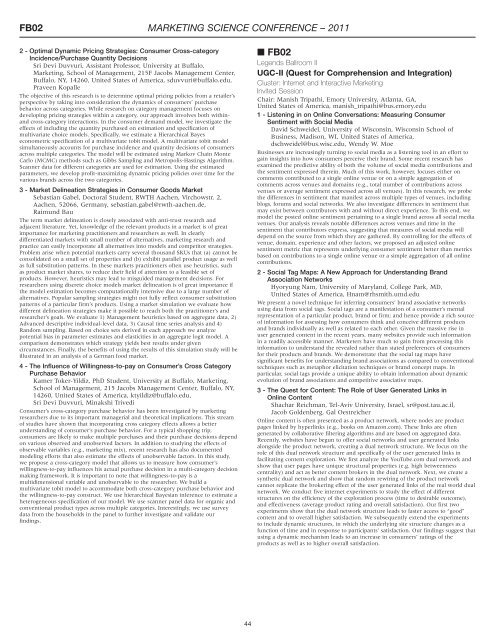Conference Sessions - Jesse H. Jones Graduate School of ...
Conference Sessions - Jesse H. Jones Graduate School of ...
Conference Sessions - Jesse H. Jones Graduate School of ...
Create successful ePaper yourself
Turn your PDF publications into a flip-book with our unique Google optimized e-Paper software.
FB02 MARKETING SCIENCE CONFERENCE – 2011<br />
2 - Optimal Dynamic Pricing Strategies: Consumer Cross-category<br />
Incidence/Purchase Quantity Decisions<br />
Sri Devi Duvvuri, Assistant Pr<strong>of</strong>essor, University at Buffalo,<br />
Marketing, <strong>School</strong> <strong>of</strong> Management, 215F Jacobs Management Center,<br />
Buffalo, NY, 14260, United States <strong>of</strong> America, sduvvuri@buffalo.edu,<br />
Praveen Kopalle<br />
The objective <strong>of</strong> this research is to determine optimal pricing policies from a retailer’s<br />
perspective by taking into consideration the dynamics <strong>of</strong> consumers’ purchase<br />
behavior across categories. While research on category management focuses on<br />
developing pricing strategies within a category, our approach involves both withinand<br />
cross-category interactions. In the consumer demand model, we investigate the<br />
effects <strong>of</strong> including the quantity purchased on estimation and specification <strong>of</strong><br />
multivariate choice models. Specifically, we estimate a Hierarchical Bayes<br />
econometric specification <strong>of</strong> a multivariate tobit model. A multivariate tobit model<br />
simultaneously accounts for purchase incidence and quantity decisions <strong>of</strong> consumers<br />
across multiple categories. The model will be estimated using Markov Chain Monte<br />
Carlo (MCMC) methods such as Gibbs Sampling and Metropolis-Hastings Algorithm.<br />
Scanner data for different categories are used for estimation. Using the estimated<br />
parameters, we develop pr<strong>of</strong>it-maximizing dynamic pricing policies over time for the<br />
various brands across the two categories.<br />
3 - Market Delineation Strategies in Consumer Goods Market<br />
Sebastian Gabel, Doctoral Student, RWTH Aachen, Virchowstr. 2,<br />
Aachen, 52066, Germany, sebastian.gabel@rwth-aachen.de,<br />
Raimund Bau<br />
The term market delineation is closely associated with anti-trust research and<br />
adjacent literature. Yet, knowledge <strong>of</strong> the relevant products in a market is <strong>of</strong> great<br />
importance for marketing practitioners and researchers as well. In clearly<br />
differentiated markets with small number <strong>of</strong> alternatives, marketing research and<br />
practice can easily incorporate all alternatives into models and competitor strategies.<br />
Problem arise when potential markets carry several thousand SKUs that (a) cannot be<br />
consolidated on a small set <strong>of</strong> properties and (b) exhibit parallel product usage as well<br />
as full substitution patterns. In these markets practitioners <strong>of</strong>ten use heuristics, such<br />
as product market shares, to reduce their field <strong>of</strong> attention to a feasible set <strong>of</strong><br />
products. However, heuristics may lead to misguided management decisions. For<br />
researchers using discrete choice models market delineation is <strong>of</strong> great importance if<br />
the model estimation becomes computationally intensive due to a large number <strong>of</strong><br />
alternatives. Popular sampling strategies might not fully reflect consumer substitution<br />
patterns <strong>of</strong> a particular firm’s products. Using a market simulation we evaluate how<br />
different delineation strategies make it possible to reach both the practitioner’s and<br />
researcher’s goals. We evaluate 1) Management heuristics based on aggregate data, 2)<br />
Advanced descriptive individual-level data, 3) Causal time series analysis and 4)<br />
Random sampling. Based on choice sets derived in each approach we analyze<br />
potential bias in parameter estimates and elasticities in an aggregate logit model. A<br />
comparison demonstrates which strategy yields best results under given<br />
circumstances. Finally, the benefits <strong>of</strong> using the results <strong>of</strong> this simulation study will be<br />
illustrated in an analysis <strong>of</strong> a German food market.<br />
4 - The Influence <strong>of</strong> Willingness-to-pay on Consumer’s Cross Category<br />
Purchase Behavior<br />
Kamer Toker-Yildiz, PhD Student, University at Buffalo, Marketing,<br />
<strong>School</strong> <strong>of</strong> Management, 215 Jacobs Management Center, Buffalo, NY,<br />
14260, United States <strong>of</strong> America, ktyildiz@buffalo.edu,<br />
Sri Devi Duvvuri, Minakshi Trivedi<br />
Consumer’s cross-category purchase behavior has been investigated by marketing<br />
researchers due to its important managerial and theoretical implications. This stream<br />
<strong>of</strong> studies have shown that incorporating cross category effects allows a better<br />
understanding <strong>of</strong> consumer’s purchase behavior. For a typical shopping trip,<br />
consumers are likely to make multiple purchases and their purchase decisions depend<br />
on various observed and unobserved factors. In addition to studying the effects <strong>of</strong><br />
observable variables (e.g., marketing mix), recent research has also documented<br />
modeling efforts that also estimate the effects <strong>of</strong> unobservable factors. In this study,<br />
we propose a cross-category model that allows us to measure how consumer’s<br />
willingness-to-pay influences his actual purchase decision in a multi-category decision<br />
making framework. It is important to note that willingness-to-pay is a<br />
multidimensional variable and unobservable to the researcher. We build a<br />
multivariate tobit model to accommodate both cross-category purchase behavior and<br />
the willingness-to-pay construct. We use hierarchical Bayesian inference to estimate a<br />
heterogeneous specification <strong>of</strong> our model. We use scanner panel data for organic and<br />
conventional product types across multiple categories. Interestingly, we use survey<br />
data from the households in the panel to further investigate and validate our<br />
findings.<br />
44<br />
■ FB02<br />
Legends Ballroom II<br />
UGC-II (Quest for Comprehension and Integration)<br />
Cluster: Internet and Interactive Marketing<br />
Invited Session<br />
Chair: Manish Tripathi, Emory University, Atlanta, GA,<br />
United States <strong>of</strong> America, manish_tripathi@bus.emory.edu<br />
1 - Listening in on Online Conversations: Measuring Consumer<br />
Sentiment with Social Media<br />
David Schweidel, University <strong>of</strong> Wisconsin, Wisconsin <strong>School</strong> <strong>of</strong><br />
Business, Madison, WI, United States <strong>of</strong> America,<br />
dschweidel@bus.wisc.edu, Wendy W. Moe<br />
Businesses are increasingly turning to social media as a listening tool in an effort to<br />
gain insights into how consumers perceive their brand. Some recent research has<br />
examined the predictive ability <strong>of</strong> both the volume <strong>of</strong> social media contributions and<br />
the sentiment expressed therein. Much <strong>of</strong> this work, however, focuses either on<br />
comments contributed to a single online venue or on a simple aggregation <strong>of</strong><br />
comments across venues and domains (e.g., total number <strong>of</strong> contributions across<br />
venues or average sentiment expressed across all venues). In this research, we probe<br />
the differences in sentiment that manifest across multiple types <strong>of</strong> venues, including<br />
blogs, forums and social networks. We also investigate differences in sentiment that<br />
may exist between contributors with and without direct experience. To this end, we<br />
model the posted online sentiment pertaining to a single brand across all social media<br />
venues. Our analysis reveals notable differences across venues and time in the<br />
sentiment that contributors express, suggesting that measures <strong>of</strong> social media will<br />
depend on the source from which they are gathered. By controlling for the effects <strong>of</strong><br />
venue, domain, experience and other factors, we proposed an adjusted online<br />
sentiment metric that represents underlying consumer sentiment better than metrics<br />
based on contributions to a single online venue or a simple aggregation <strong>of</strong> all online<br />
contributions.<br />
2 - Social Tag Maps: A New Approach for Understanding Brand<br />
Association Networks<br />
Hyoryung Nam, University <strong>of</strong> Maryland, College Park, MD,<br />
United States <strong>of</strong> America, Hnam@rhsmith.umd.edu<br />
We present a novel technique for inferring consumers’ brand associative networks<br />
using data from social tags. Social tags are a manifestation <strong>of</strong> a consumer’s mental<br />
representation <strong>of</strong> a particular product, brand or firm; and hence provide a rich source<br />
<strong>of</strong> information for assessing how consumers think and conceive different products<br />
and brands individually as well as related to each other. Given the massive rise in<br />
user generated content in the recent years, many websites provide such information<br />
in a readily accessible manner. Marketers have much to gain from processing this<br />
information to understand the revealed rather than stated preferences <strong>of</strong> consumers<br />
for their products and brands. We demonstrate that the social tag maps have<br />
significant benefits for understanding brand associations as compared to conventional<br />
techniques such as metaphor elicitation techniques or brand concept maps. In<br />
particular, social tags provide a unique ability to obtain information about dynamic<br />
evolution <strong>of</strong> brand associations and competitive associative maps.<br />
3 - The Quest for Content: The Role <strong>of</strong> User Generated Links in<br />
Online Content<br />
Shachar Reichman, Tel-Aviv University, Israel, sr@post.tau.ac.il,<br />
Jacob Goldenberg, Gal Oestreicher<br />
Online content is <strong>of</strong>ten presented as a product network, where nodes are product<br />
pages linked by hyperlinks (e.g., books on Amazon.com). These links are <strong>of</strong>ten<br />
generated by collaborative filtering algorithms and are based on aggregated data.<br />
Recently, websites have begun to <strong>of</strong>fer social networks and user generated links<br />
alongside the product network, creating a dual network structure. We focus on the<br />
role <strong>of</strong> this dual network structure and specifically <strong>of</strong> the user generated links in<br />
facilitating content exploration. We first analyze the YouTube.com dual network and<br />
show that user pages have unique structural properties (e.g. high betweenness<br />
centrality) and act as better content brokers in the dual network. Next, we create a<br />
synthetic dual network and show that random rewiring <strong>of</strong> the product network<br />
cannot replicate the brokering effect <strong>of</strong> the user generated links <strong>of</strong> the real world dual<br />
network. We conduct five internet experiments to study the effect <strong>of</strong> different<br />
structures on the efficiency <strong>of</strong> the exploration process (time to desirable outcome),<br />
and effectiveness (average product rating and overall satisfaction). Our first two<br />
experiments show that the dual network structure leads to faster access to “good”<br />
content and to overall higher satisfaction. We subsequently extend the experiments<br />
to include dynamic structures, in which the underlying site structure changes as a<br />
function <strong>of</strong> time and in response to participants’ satisfaction. Our findings suggest that<br />
using a dynamic mechanism leads to an increase in consumers’ ratings <strong>of</strong> the<br />
products as well as to higher overall satisfaction.

















